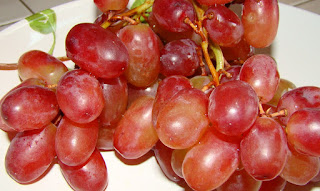

Finger fruit, grapes are small round or oval berries that feature a semi-translucent flesh encased by a smooth skin. Some contain edible seeds, while others are seedless.
Grapes that are eaten from the vine are called table grapes, as opposed to wine grapes (used in viniculture) or raisin grapes. (Dried grapes are referred to as 'raisins'.)
Grapes come in a variety of colors including green, amber, red, blue-black, and purple. Color, size, taste and physical characteristics differ amongst the varieties. For the most antioxidants, choose fully ripened grapes.
Choose grapes that are plump and free from wrinkles. They should be intact, not leaking juice, and firmly attached to a healthy looking stem. One way to evaluate the sweetness of grapes is by their color, it should be deep and rich in color.
Since grapes tend to spoil and ferment at room temperature, they should always be stored in the refrigerator. Loosely wrap unwashed grapes in a paper towel and place them in a plastic bag. This way, they'll keep fresh in the refrigerator for several days.
Grapes should be washed under cold running water right before consuming. After washing, either drain the grapes in a colander or gently pat them dry. If you are not going to consume the whole bunch at one time, use scissors to separate small clusters of grapes from the stem instead of removing individual grapes. This will help keep the remaining grapes fresher by preventing the stem from drying out.
Grapes can be eaten raw or used for making jam, juice, jelly, vinegar, wine or raisins.
Grapes are a wonderful addition to any fruit salad; consider using a few different varieties of grapes.
Give your curries a fruity punch by including fresh grapes in the recipe.
Add grapes to mixed green salads.
Nutritional Profile
Grapes are excellent sources of manganese, good sources of vitamin B6, vitamin B1, potassium, and vitamin C, in addition, grapes contain antioxidant compounds.








No comments:
Post a Comment